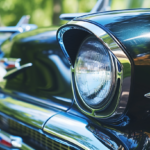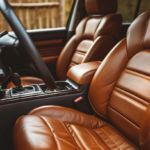Want to keep your car’s body in pristine condition? Learn how to prevent rust and keep your vehicle looking brand new. In this article, we’ll guide you through the causes of car rust, proper cleaning techniques, the importance of waxing and polishing, and tips for choosing the right rust inhibitor products. We’ll also provide advice on protecting vulnerable areas, storing your car, and inspecting and repairing small rust spots. Say goodbye to rust and hello to a well-maintained car!
Understanding the Causes of Car Rust
First, you need to understand the three main causes of car rust. Ignoring these causes can lead to costly repairs and damage to your car’s body. The first cause is exposure to moisture. When water comes into contact with your car’s metal surface, it can cause a chemical reaction that leads to rust formation. This is why it’s important to dry your car thoroughly after it gets wet. The second cause is road salt. Salt is commonly used to melt ice on roads during winter, but it can also accelerate rusting on your car. Regularly washing the undercarriage of your car can help remove salt residue and prevent rust. Lastly, scratches and chips in the paint can expose the metal underneath to moisture and air, creating the perfect conditions for rust to develop. It’s crucial to repair any paint damage promptly to prevent rust from spreading. By understanding these causes, you can take the necessary steps to protect your car’s body from rust.
Regular Car Washing and Cleaning Techniques
To keep your car’s body rust-free, you should regularly wash and clean it using proper techniques. Regular car washing is essential to remove dirt, debris, and road salt, which can accelerate rust formation. Start by rinsing your car with water to remove loose dirt and grime. Then, use a mild car wash soap and a soft sponge or microfiber cloth to gently scrub the surface. Pay extra attention to the areas prone to rust, such as the wheel wells and the underside of your car. After washing, thoroughly rinse off the soap with clean water and dry the car using a soft towel or a chamois. Additionally, don’t forget to clean the inside of your car to prevent moisture buildup, as this can also contribute to rust formation.
The Importance of Waxing and Polishing
By regularly waxing and polishing your car, you can protect its body from rust and maintain a shiny, pristine appearance. Waxing creates a protective barrier on the car’s surface, preventing moisture and other elements from coming into direct contact with the metal. This is important because moisture is one of the main causes of rust formation. When you wax your car, you are essentially sealing the paint and preventing any rust-causing agents from penetrating the surface. Polishing, on the other hand, helps to remove any minor scratches or imperfections on the paint, giving your car a smooth and glossy finish. It also helps to enhance the color and shine of the paint, making your car look brand new. So, make sure to include regular waxing and polishing in your car maintenance routine to keep it rust-free and looking its best.
Choosing the Right Rust Inhibitor Products
You can find a variety of rust inhibitor products that are designed to protect your car’s body from corrosion and rust. When choosing the right rust inhibitor products, it’s important to consider the type of protection you need and the specific needs of your car. One option is a rust converter, which chemically converts rust into a protective barrier. This can be a good choice if you already have rust on your car’s body. Another option is a rust preventive spray or coating, which creates a barrier between the metal and moisture to prevent rust from forming. These can be applied to both new and existing cars. Additionally, you can also find rust inhibitor paints, which provide long-lasting protection and can be applied directly to the affected areas. Consider the specific needs of your car and choose the rust inhibitor product that best suits your requirements.
Protecting Vulnerable Areas of Your Car’s Body
Inspecting and regularly maintaining vulnerable areas can help prevent rust from forming on your car’s body. These vulnerable areas include the wheel wells, the undercarriage, and the bottom of the doors. Start by inspecting these areas for any signs of rust or damage. If you notice any chips or scratches in the paint, it’s important to touch them up as soon as possible to prevent rust from developing. You can do this by using touch-up paint that matches your car’s color. Additionally, make sure to clean these areas regularly to remove any dirt, debris, or road salt that can contribute to rust formation. Applying a rust inhibitor or protective wax can also provide an extra layer of defense against rust. By taking these preventive measures, you can prolong the lifespan of your car’s body and keep it rust-free for years to come.
Tips for Properly Storing Your Car
During the colder months, ensure that your car is stored in a dry and protected area, such as a garage or carport, to shield it from the elements and prevent rust. Moisture and freezing temperatures can accelerate rust formation, so it’s crucial to keep your car in a sheltered environment. If you don’t have access to a garage or carport, consider investing in a car cover to protect your vehicle from rain, snow, and other weather conditions. Before storing your car, make sure to clean it thoroughly to remove any dirt or debris that could potentially cause damage. Additionally, check the tire pressure and inflate them to the recommended level, as properly inflated tires can help prevent flat spots. By taking these precautions, you can ensure that your car stays in good condition while in storage.
Inspecting and Repairing Small Rust Spots
Now let’s talk about how to inspect and repair small rust spots on your car’s body. There are various spot treatment techniques you can use to address these areas before they worsen. Additionally, implementing preventive maintenance tips will help ensure that new rust spots don’t form in the future.
Spot Treatment Techniques
To effectively address those annoying small rust spots on your car, it’s important to take a proactive approach. Spot treatment techniques can help you inspect and repair these small rust spots before they become a bigger problem. Start by thoroughly cleaning the affected area with soap and water, and then use a wire brush or sandpaper to remove any loose rust or paint. Once the surface is clean, apply a rust converter or primer to prevent further rusting. After the converter or primer has dried, you can touch up the area with matching paint to blend it in seamlessly with the rest of your car’s body. Regularly inspecting and treating these small rust spots will help keep your car looking great and prevent rust from spreading.
Preventive Maintenance Tips
Take a proactive approach by regularly inspecting and repairing small rust spots on your car’s body to prevent further damage. Small rust spots can quickly spread and cause significant damage to your vehicle if left untreated. To start, give your car a thorough cleaning to remove any dirt or debris that may be hiding rust spots. Once clean, carefully inspect the body of your car, paying close attention to areas prone to rust, such as the wheel wells, undercarriage, and around the door edges. If you spot any small rust spots, don’t wait to take action. Use sandpaper to gently remove the rust, then apply a primer and touch-up paint to prevent further corrosion. Taking the time to inspect and repair small rust spots will help keep your car’s body in good condition and extend its lifespan.

Lucas is an experienced vehicle technician with hands-on knowledge of almost every car brand available. Throughout his career, Lucas has worked on a wide range of vehicles, including domestic and foreign models, sports cars, trucks, and SUVs.





